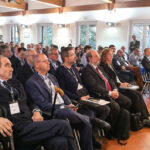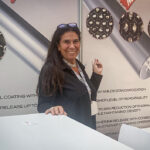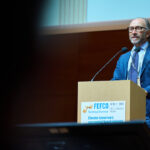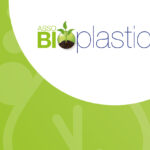Reduce, Reuse and Recycle are the three “Rs” of good packaging. At the convention organized April 3rd by I&C Packaging Academy a fourth one, Reflection, the updating and swapping of experiences and opinions, was added. Sante Conselvan’s suggestion went down well, and during the day laws, procedures, technologies and products, ideas and opportunities were pondered and discussed.
 The arduous task of summing up the normative framework, here meaning European regulations on FCMs (Food Contact Materials), was ably carried out by Marco Pasqualini of AIMO-FCE, who also who also announced the imminent arrival of a new law by decree (n. 1324) on food safety and tackled the common perception of food risk, and documented the reasons for focussing on the same (in 2012 10% of the alerts regarding foodstuffs were caused by FCMs). Having broached the problem, the solution was proposed: working in accordance with the GMPs, these divided into the two large families: actions for ensuring compliance with processing hygiene requisites (Regulation 2023/CE/06) and those ensuring product safety (Regulation 1935/CE/04).
The arduous task of summing up the normative framework, here meaning European regulations on FCMs (Food Contact Materials), was ably carried out by Marco Pasqualini of AIMO-FCE, who also who also announced the imminent arrival of a new law by decree (n. 1324) on food safety and tackled the common perception of food risk, and documented the reasons for focussing on the same (in 2012 10% of the alerts regarding foodstuffs were caused by FCMs). Having broached the problem, the solution was proposed: working in accordance with the GMPs, these divided into the two large families: actions for ensuring compliance with processing hygiene requisites (Regulation 2023/CE/06) and those ensuring product safety (Regulation 1935/CE/04).
This the start – full of substantial info – of the convention “food packaging: new features to compete”, organized April 3rd last by I&C Packaging Academy in cooperation with the agency COM, headed by Maria Laura Lombardi. Now in its second edition, after the success of June 2013 at Padua, held at the impressive Cascina La Lodovica, at Oreno di Vimercate (MB), the convention was mainly attended by guests from central-northern Italy and was sponsored by Huber, Luxoro, Eutro Log, Grafikontrol, Kodak, ICR, Imac, Edigit, Gama, I&C and Camis.
Rules, procedures, verification
Full of substantialities the opening and welcome address, made by Sante Conselvan, head of I&C, creator of the encounter and an enthusiastic supporter of “continuous training” and the interchange of knowledge and knowhow, reflecting the the equally concrete talks held by the other experts that followed, with Emilio Gerboni in the role of “moderator”:
After that of Pasqualini, Maria Zemiar Noviti (Studio zetapi), expounded the subject of converters’ food safety obligations and responsibilities with her usual systematic clarity, stating that – in the absence of a manual indicating the correct procedures – each and everyone should devise their own method. This should start out by pinpointing criticalities, subsequently evaluating the physical, chemical and biological contaminations and lastly devising the solution for the case at hand suggested by regulations and standards, the customers and not least pure, plain common sense.
The third talk, under the title “Food contact materials: conformity the consequence of a correct risk analysis”, the most technical of them all, was given with admirable clarity by Gianluigi Vestrucci (Pack.Co Srl).

He started by listing the type of risk and the example of a correct cataloguing taken from the practices of a well organized flexible packaging converter; a focus on the chemical contaminants present in packaging material and on the NIAS (non intentionally added substances), such as process coadjutants, products of reaction etc. was proposed. The expert then explained how to carry out cost-effective research offering the best possible returns in knowhow, not without rendering the complexity of the subject, while leading to the proposal of manageable solutions with sustainable times and resources, to attain an adequate degree of certainty and safety (throughout the proceedings appeals to common sense were frequent).
Technology…
After the “technicians” the representatives of industry showed how technologies and print products and packaging enhancement can contribute decisively to safety, distinctiveness and the sustainability of the same, constituting a basic resource for the brand owner.
Giuseppe Gianetti of Huber illustrated his company’s high tech food ink philosophy and proposals, with a focus on the Gecko solvent based products for the flexible packaging printing. Gianni Azaretti of Luxoro in turn spoke of of “Enhancement and indirect contact with the food packaging”. Ivan Parisi of Eutro Log gave a dual talk with his new partner David Malik (Laem System) on the fundamental contribution automation offers to the food & beverage industry. Francesco Bordoni, head of the consultancy company Ci.Ti.O and expert at the Milan court of law, dedicated his talk “Beyond the ‘conventional”: the future is already here” to the extraordinary growth and the equally promising prospects of electronic printing, defined as the third revolution in the sector, following Gutenberg and the advent of the digital era. After the morning break the topic “Manufacture and standardisation of packaging technology” was broached by Alberto Sironi and Filippo Bacile (CERTIpack), followed by the round table discussion.
 … and marketing
… and marketing
The talk given by Luca Zocca of Pedon Group entitled “food packaging between marketing and sustainability” deserves a special mention.
This is due both to the importance of this integrated own brand and private label “food commodity” producer (600 employees, 90 billion of turnover in 2013, 5 works in Italy, China, Ethiopia, Argentina, Egypt; and on top of that: 58 refrigerated silos, 16 automated packaging lines, a 7,500 pallet finished products storage facilities…) as well as to the effectiveness of its commercial policies that sees it with a foothold on 25 markets with 4 successful business areas, a quality policy with very high standards, an ethical code that translates into many important undertakings… as well as the importance assigned to packaging that is among the distinguishing features of the Veneto based company.
Zocca illustrated a series of emblematic solutions of coherence between vestige and contents, clarity of consumer info (slide a), and attention to the functional performance directed towards guaranteeing the best service to the end user and the max effectiveness of the logistics chain, ending up with the shelf (slide b and c). Great their care for sustainability, that among other things translates into the systematic use of recycled or FSC certified paper, recyclable packaging, 100% wind farm energy, containment of the use of primary packaging (for example with the implementation of the bag-in-box), reduction in the weight and size of the packaging, pallet optimisation, reduced road transport and much more.
Ending with debate
Lastly, the end of convention round table discussion, that gradually lost its formality while being full of content, enabled each segment of the chain to air its demands and problems.
There was a vibrant exchange of ideas on the vexed question of the costs and prices that divides the machine and packaging suppliers from the users (here represented by the spokesperson for the largescale retail trade), everyone having to deal with the too short blanket of the margins to be safeguarded. And at the end of the debate the bridging of the gap between the parties appeared less problematic.











